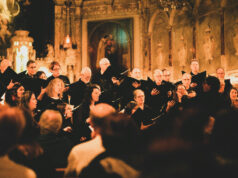Q&A with La Luna Roja’s Sorceress

TEACHING and theater seem to go together for Tami Monsod. Before playing the role of the witch in La Luna Roja, the veteran theater actress was a lonely, loveless, and dying professor in Wit. Like that character (at least the professor part), Ms. Monsod is also a teacher in real life. She has a masters in theater and currently teaches theater to high school students at the International School Manila.
Teaching seems to run in the Monsod family. Her mother Solita “Winnie” Monsod is a noted UP professor, television host, and economist.
While she took theater classes in college, Ms. Monsod was a Spanish and Economics major. But she realizes that theater has always been calling her, so she gives in to the order and has acted with groups like Dulaang UP, Actor’s Actors, Inc., and New Voice Company.
She received the 2014 Philstage Gawad Buhay award for playing one of the daughters of the Weston family who had to face her own demons in Repertory Philippines’ August: Osage Country. In 2014, she directed Last 10 Minutes, a Virgin Labfest show.
Ms. Monsod talked with BusinessWorld about sorcery, flamenco, short hair, and meeting one’s duende.
Did you cut your hair as part of your role as a sorceress?
I shaved my head last April for my role in Wit, and have kept it short ever since. While women in flamenco normally have long hair, I feel short hair on the sorceress would highlight her aggressiveness and non-conformity.
Can you tell us more about your role and how you are preparing for it?
My preparation for the role has been challenging. Emma, our teacher and creator of the piece, cast me as Sorceress because I am an actor and she felt this was central to the role. However, because the piece is a flamenco ballet, she has also had to work on my dance technique. After discussion about character, Emma let me improvise on the Sorceress’ movement and then she refined it so it incorporated flamenco form.
One of the biggest challenges in teaching flamenco is bringing out the duende (passion) in students, how did you deal with your own duende?
I see duende as a moment of spiritual, emotional, and physical brilliance in performance. We all hope for it. Even with excellent technique and skill, though, duende can be elusive. Emma is right when she says it is her biggest challenge.
How was your process of becoming a “fearless” flamenco dancer?
What makes you think I am fearless? As a performer I am almost always beset with fear. After decades of experience, it has never left me. I think I have reached the equivalent of duende as an actor only once in my career, where I became lost in a moment and “came to” afterwards.
La Luna Roja has a niche market, and it’s not the young adults/millennials. Why should the youth watch it and other flamenco dances?
The first time I saw a flamenco performance in Sevilla, I cried. The passion was startling and resonated with my life experiences. With more exposure to flamenco, young adults and millennials here in the Philippines will fall in love with it, too.
What are the differences and similarities between theater and flamenco?
I think the differences are apparent. I’d like to address the similarities: Both require years of technical study, mindful repetition, and an understanding of text, subtext, and interior monologue. Both require stamina. Both require courage. — NFPDG


